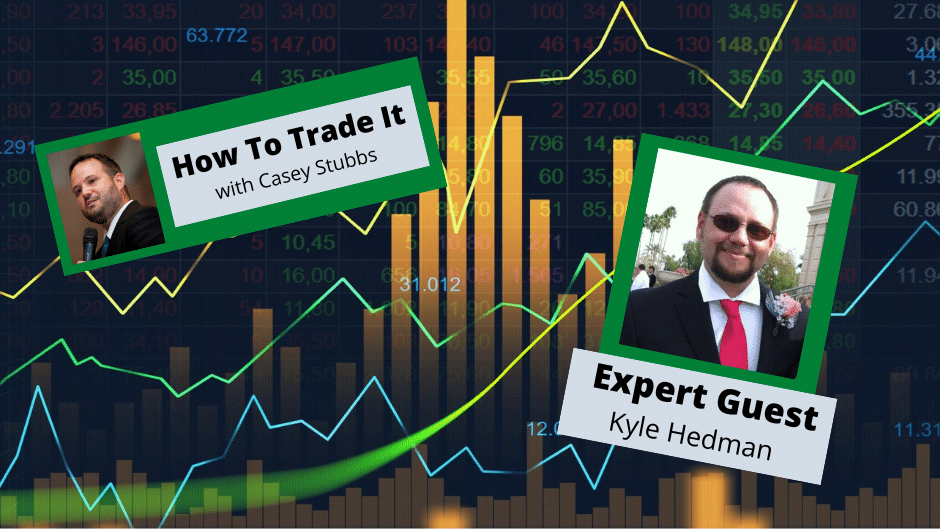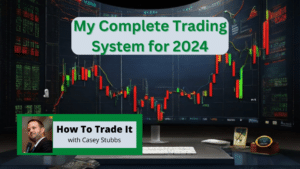Optimizing Success: A Dive into Adaptive Trading Strategies

In today’s episode of the How To Trade It podcast, Casey and Kyle Hedman take a deep dive into adaptive trading strategies. They discuss various aspects of trading, including the influence of Nicholas Darvas’ book, avoiding shiny object syndrome, and focusing on execution. They share their biggest lessons learned and provide insights into their trading journeys. You don’t want to miss it!
Subscribe to How To Trade It
Key Takeaways…
- The importance of self-discovery and understanding your own tendencies and biases in trading
- The significance of building good trading habits and prioritizing relationships and life balance
- The value of learning from mistakes and celebrating wins in trading
- The need for back testing and sticking to your edge in order to achieve consistent trading success
More about Kyle…
Kyle Hedman is a self-employed trader, and co-host of the Band of Traders podcast. He began his journey to becoming a full-time trader with an investment mindset and the goal of early retirement from his career.
Very early in adulthood, while serving in the Navy, Kyle developed a plan for early retirement, with the goal of retiring before the age of 40. He began and maintained long-term investments, created passive income with rental properties, and maintained a debt-free lifestyle.
Kyle had dabbled in stock trading, but had more of an investment mindset. In 2020, with lockdowns and more time on their hands, Kyle and his lifelong friend, Dan Leeson, started becoming more interested in active trading. They started talking daily about the trades they had made, what they were interested in, what they had learned, and what they had lost.
They are both naturally self-deprecating, and as they laughed at their failures, they wondered whether anyone else would be interested in what they were doing, so they started a podcast to talk about it. The podcast opened doors to people, communities, and learning opportunities that changed everything. Kyle discovered his true passion in trading, learning, and the communities that he joined and helped create.
Adaptive Trading Strategies
Adaptive trading strategies refer to approaches in the financial markets that adjust or evolve based on changing market conditions. These strategies aim to adapt to various market scenarios, volatility levels, trends, and other dynamic factors. Here are a few adaptive trading strategies:
- Moving Averages: Using moving averages that adjust their sensitivity to market fluctuations. For instance, adaptive moving averages change their periods based on market volatility, aiming to reduce lag during trending markets and smoothen fluctuations during choppy periods.
- Volatility-Based Strategies: Employing indicators or algorithms that adapt to volatility changes. These strategies might include adjusting position sizes or entry/exit criteria based on market volatility levels.
- Dynamic Risk Management: Implementing risk management techniques that adapt to market conditions. This could involve adjusting stop-loss levels, position sizes, or portfolio allocations based on changes in market volatility or trends.
- Machine Learning Algorithms: Using artificial intelligence or machine learning models that continuously learn and adjust to market patterns. These algorithms adapt their strategies based on new data, aiming to improve predictive accuracy over time.
- Adaptive Trend-Following Strategies: Employing trend-following methods that adjust their parameters based on market conditions. This might involve using different time frames or trend identification techniques depending on the current market trend.
- Pattern Recognition with Dynamic Thresholds: Utilizing pattern recognition techniques that adjust their criteria for identifying patterns based on current market conditions. This adaptation helps in differentiating between genuine signals and noise.
Adaptive trading strategies enhance a trader’s ability to navigate varying market conditions, minimizing losses during unfavorable conditions and capitalizing on opportunities during favorable ones. However, implementing adaptive trading strategies requires rigorous testing, validation, and continuous monitoring to ensure their effectiveness across changing market environments.
Shiny Object Syndrome
In trading, Shiny Object Syndrome describes a pattern where traders frequently switch strategies, methodologies, or assets due to the allure of new, trendy, or seemingly promising trading ideas. This behavior often leads to a lack of consistency and focus, hindering a trader’s ability to develop expertise or achieve success in a particular trading approach.
Traders affected by this syndrome may continuously seek the next “hot” strategy or market trend without fully mastering or testing their current methods, ultimately undermining their progress and potential for sustained profitability in the markets. Overcoming this syndrome involves discipline, sticking to a well-researched trading plan, and avoiding impulsive shifts based solely on short-term trends or the allure of new strategies.
Back Testing
Back testing is a critical process in trading where historical market data is used to assess the viability and effectiveness of a trading strategy. Traders simulate applying a specific set of rules or indicators to past market data to evaluate how the strategy would have performed in real-time conditions.
Its importance lies in several key aspects:
- Strategy Validation: Back testing helps validate a trading strategy by applying it to historical data. It provides empirical evidence on whether the strategy would have been profitable in the past.
- Risk Assessment: It allows traders to understand the potential risks associated with the strategy by analyzing drawdowns, volatility, and worst-case scenarios in historical contexts.
- Performance Evaluation: Traders can assess the strategy’s performance metrics such as profitability, win rate, risk-to-reward ratio, and other vital statistics.
- Improvement and Optimization: It helps refine and optimize trading strategies by identifying strengths, weaknesses, and areas for improvement based on historical results.
- Confidence Building: Successful backtesting can instill confidence in a trader, reinforcing their belief in a strategy and its potential for success in current market conditions.
Connect with Kyle Hedman
- Podcast: Band of Traders
- YouTube: https://www.youtube.com/channel/UC3elVqhNecYCZuy9PPCLJgg
- Twitter: https://twitter.com/FinancialInept1
- Facebook: https://www.facebook.com/Financialineptitude
- Email: teaminept@financialineptitude.com
Connect With Casey Stubbs
- Website: https://tradingstrategyguides.com/
- Website: https://caseystubbs.com
- Website: https://globalproptrader.com/
- YouTube: https://www.youtube.com/TradingStrategyGuides
- YouTube: https://www.youtube.com/caseystubbs
- Twitter: https://www.twitter.com/caseystubbs
- Facebook: https://www.facebook.com/TradingStrategyGuides
- LinkedIn: https://www.linkedin.com/in/caseystubbs/
Subscribe to How To Trade It
Disclaimer: Trading carries a high level of risk, and may not be suitable for all investors. Before deciding to invest you should carefully consider your investment objectives, level of experience, and risk appetite. The possibility exists that you could sustain a loss of some or all of your initial investment. Therefore, you should not invest money that you cannot afford to lose. You should be aware of all the risks associated with foreign exchange trading, and seek advice from an independent financial advisor if you have any doubts.






